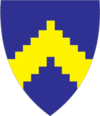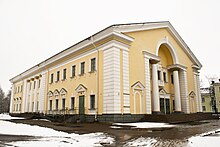Sillamae
| Sillamae | |||
|
|||
| State : |
|
||
| Circle : |
|
||
| Founded : | 1957 (city rights) | ||
| Coordinates : | 59 ° 24 ' N , 27 ° 46' E | ||
| Area : | 10.54 km² | ||
| Residents : | 12,989 (January 1, 2018) | ||
| Population density : | 1,232 inhabitants per km² | ||
| Time zone : | EET (UTC + 2) | ||
| Telephone code : | (+372) 033 | ||
| Postal code : | 40231 | ||
| Community type: | city | ||
| Mayor : | Jelena Koršunova
( Keskerakond ) |
||
| Postal address : | Kesk 27 40231 Sillamäe |
||
| Website : | |||
| City Festival : | June 29th | ||

|
|||
Sillamäe (German Sillamäggi ) is a city in the northeast of the Republic of Estonia .
location
Sillamäe belongs to the Ida-Viru county . The city covers an area of 10.54 km².
The distance to the third largest Estonian city Narva is 25 kilometers. It is 180 kilometers to the Estonian capital Tallinn and the Russian metropolis Saint Petersburg . The nearest passenger station is in Vaivara, three kilometers away .
The strongly industrialized Sillamäe is located directly on the Gulf of Finland , not far from the border between Estonia and Russia . The Sõtke River ( Sõtke jõgi ) flows into the Baltic Sea at Sillamäe .
history
Sillamäe (Estonian meaning "mountain by the bridge") was first mentioned in 1502 as Tor Bruggen . The place had the right to be a jug . Around 1700 there was a bridge over the Sõtke River and a mill there.
In the vicinity of the fishing village on the Baltic Sea, the manor of Türsamäe (German Türsel ) developed from the 16th century . The historic mansion was demolished in the 1950s.
Seaside resort
In the 19th century the leisurely Sillamäe - like the nearby Narva-Jõesuu (German Hungerburg ) - developed into a fashionable bathing and villa resort for the upper class of the Russian capital Saint Petersburg. Intellectuals such as the composer Pjotr Taschaikowski , the physicist Paul Ehrenfest and the inventor Boris Rosing also regularly stayed in the city for relaxation and beach fun . The Nobel laureate and physiologist Ivan Pavlov spent the summers here in his dacha from 1891 . At the beginning of the 20th century, there were around 1,500 holidaymakers for the fewer than 700 inhabitants. 80% of the buildings were summer houses.
industrialization
At the beginning of the 20th century, alongside tourism, industrialization began in Sillamäe. The Estonian oil shale industry was established near the place .
Industrial development accelerated in the interwar period . Between 1927 and 1929 the Swedish Estländska Oljeskifferkonsortiet built an oil shale plant and a power station. In 1938 a second plant was put into operation. In 1939 the company employed 870 people on site.
In 1936 the export port of Sillamäe was inaugurated. It was destroyed during the Second World War.
Second World War
During the German occupation of Estonia (1941–1944), the National Socialists set up concentration and labor camps in the vicinity of Sillamäe. The forced laborers were used to work in the mines.
In 1944, in the course of the battle for the Narva bridgehead, the so-called Tannenberg positions were built near Sillamäe as a line of defense against the advancing Soviet forces. The Germans set up their defensive positions on the mountains east of Sillamäe ( Sinimäed ). In the summer of 1944, weeks of heavy fighting between the German Wehrmacht and the Red Army took place near Sillamäe . Most of the buildings were destroyed.
Soviet occupation
With the Soviet occupation of Estonia, industrialization was accelerated. Prisoners of war and convicts from the Gulag Türsamäe, established in 1947, were also used. In 1946 the plans for the construction of a steel works for the processing of oil shale ores arose .
Uranium oxide was extracted from local mining products on a five-hectare coastal area until 1952, then imported to Sillamäe from Central Asia and other Eastern Bloc countries until 1977 . In 1969 local mining was finally stopped.
During the existence of the Estonian SSR , important factories of the Soviet armaments industry were built on site under great secrecy. In 1948 a uranium enrichment plant for Soviet nuclear power plants and nuclear weapons was built. It was closed in 1989. In 1970 a factory for processing rare metals and earth started its work. In 1968, Sillamäe was expanded to include large workers' quarters. The population of Sillamae rose sharply in the following years due to the influx of Slavic-speaking workers from other parts of the Soviet Union.
Until the collapse of the Soviet Union, Sillamäe was a closed city . Foreigners were only allowed to enter under the strictest conditions. Sillamäe did not exist on the Soviet maps, there were no postal addresses. Letters were only delivered using code addresses.
In 1949 the place became a large village ( alevik ), in 1957 Sillamäe received city rights. Surrounding settlements like Kannuka and Türsamäe were incorporated.
Environmental degradation
The uranium plants caused long-lasting environmental damage that has not yet been overcome. In the north-western part of the city there is a nuclear and chemically contaminated storage pond directly on the Baltic Sea coast. There are still six million tons of radioactive and toxic waste products in the 33 hectares of diked water.
Economy today
After uranium enrichment ended in 1989 and Estonia regained its independence in 1991, industrial production in Sillamäe fell sharply. The economic crisis has led to an exodus from the city. Unemployment is still high.
In 1997 the former uranium enrichment plant was privatized. The Silmet company has specialized in the processing of rare earths and metals, in particular niobium , tantalum , lanthanum and cerium .
Another important employer is Eesti Energia Kaevandused AS , a subsidiary of Eesti Põlevkivi , which continues to mine oil shale near Sillamäe.
In 1992 the Sillamäe beer factory ( Sillamäe Õlletehas ) started operations. The beer is made there according to the recipes of the German master brewer Karl Heinz Radke.
In 2005 the deep sea port of Sillamäe was completed. There was only a short time there was a car ferry to Kotka / Finland; today it is a pure freight port.
population
Sillamäe has 12,989 inhabitants (as of January 1, 2018). As everywhere in north-eastern Estonia, the population continues to decline. The majority of the population of Sillamae is Russian-speaking.
Population development
| year | 1940 | 1965 | 1994 | 2004 | 2006 | 2010 | 2011 | 2017 | 2018 |
|---|---|---|---|---|---|---|---|---|---|
| Residents | 2,642 | 9,838 | 20,104 | 16.806 | 16,567 | 16,183 | 15,458 | 13,288 | 12,989 |
Ethnic composition (2000 census):
Districts
Sillamäe is divided into four districts. To the west of the Sõtke River, in the area of the old Türsamäe manor, is the AS Silmet industrial zone . The other three districts are east of the river:
- the 1940s and 1950s district with Stalinist-style buildings , avenues and the beach promenade with its famous stairs
- a workers' settlement with five-story houses built in the 1960s and 1970s
- a quarter from the 1980s with five to nine storey houses made of red brick. The buildings are type structures, as they were erected throughout the Soviet Union.
There is also the 600 hectare free zone and the harbor.
Attractions
During the Stalinist era, avenues were laid out in the center of Sillamäe, some of which lead directly to the Baltic Sea. Striking buildings are the town hall with its high clock tower modeled on the Lutheran church buildings and the neoclassical culture house. The city's nuclear shelter was located under the building.
The city museum, established in 1995, offers an overview of the history of the place. In the “Mineral Hall” there is an exhibition of rocks from Estonia and other areas of the former Soviet Union.
A popular local recreational destination is the Langevoja waterfall ( Langevoja juga ). It is located about one kilometer southwest of the city. The waterfall is ten meters wide. The water flows over two cascades of 1.5 m and 4 m.
Town twinning
Sillamäe maintains partnership relationships with
-
 Nokia
Nokia
-
 Kotka
Kotka
-
 Havre de Grace ( Maryland )
Havre de Grace ( Maryland ) -
 Bützow
Bützow
-
 Brovary
Brovary
-
 Mszislau
Mszislau
-
 Nekrasov District , Yaroslavl Oblast
Nekrasov District , Yaroslavl Oblast
-
 Kingissepp
Kingissepp
-
 Kärdla
Kärdla
Web links
- Official website
- Entry in Eesti Entsüklopeedia (online version)
- city Museum
Individual evidence
- ↑ http://www.visitestonia.com/de/stadt-sillamae
- ↑ http://www.estonica.org/en/Nature/Industrial_landscapes_in_Northeast_Estonia/The_metallurgy_factory_and_former_uranium_mine_in_Sillam%C3%A4e/
- ↑ http://coldwarsites.net/country/estonia/sillamae-a-closed-military-town-sillamae-museum
- ↑ http://www.eestigiid.ee/?CatID=53
- ↑ http://www.beerguide.ee/sillamae.html
- ↑ http://sillamae.kovtp.ee/et/c/document_library/get_file?uuid=12c3cf10-29be-4e75-8e9c-44f5a9deee34&groupId=419001 ( page no longer available , search in web archives ) Info: The link was automatically defective marked. Please check the link according to the instructions and then remove this notice.
- ↑ a b Statistics Estonia: Population by sex, age and place of residence after the 2017 administrative reform, 1 January. Retrieved February 17, 2019 .






